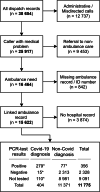Prehospital identification of Covid-19: an observational study
- PMID: 33407750
- PMCID: PMC7786859
- DOI: 10.1186/s13049-020-00826-6
Prehospital identification of Covid-19: an observational study
Abstract
Background: The novel coronavirus disease 2019 (Covid-19) pandemic has affected prehospital care systems across the world, but the prehospital presentation of affected patients and the extent to which prehospital care providers are able to identify them is not well characterized. In this study, we describe the presentation of Covid-19 patients in a Swedish prehospital care system, and asses the predictive value of Covid-19 suspicion as documented by dispatch and ambulance nurses.
Methods: Data for all patients with dispatch, ambulance, and hospital records between January 1-August 31, 2020 were extracted. A descriptive statistical analysis of patients with and without hospital-confirmed Covid-19 was performed. In a subset of records beginning from April 14, we assessed the sensitivity and specificity of documented Covid-19 suspicion in dispatch and ambulance patient care records.
Results: A total of 11,894 prehospital records were included, of which 481 had a primary hospital diagnosis code related to-, or positive test results for Covid-19. Covid-19-positive patients had considerably worse outcomes than patients with negative test results, with 30-day mortality rates of 24% vs 11%, but lower levels of prehospital acuity (e.g. emergent transport rates of 14% vs 22%). About half (46%) of Covid-19-positive patients presented to dispatchers with primary complaints typically associated with Covid-19. Six thousand seven hundred seventy-six records were included in the assessment of predictive value. Sensitivity was 76% (95% CI 71-80) and 82% (78-86) for dispatch and ambulance suspicion respectively, while specificities were 86% (85-87) and 78% (77-79).
Conclusions: While prehospital suspicion was strongly indicative of hospital-confirmed Covid-19, based on the sensitivity identified in this study, prehospital suspicion should not be relied upon as a single factor to rule out the need for isolation precautions. The data provided may be used to develop improved guidelines for identifying Covid-19 patients in the prehospital setting.
Conflict of interest statement
The authors are employed by the regional ambulance service studied. The authors declare that they have no further competing interests.
Figures




Similar articles
-
A Dispatch Screening Tool to Identify Patients at High Risk for COVID-19 in the Prehospital Setting.West J Emerg Med. 2021 Oct 27;22(6):1253-1256. doi: 10.5811/westjem.2021.8.52563. West J Emerg Med. 2021. PMID: 34787547 Free PMC article.
-
COVID-19 Preliminary Case Series: Characteristics of EMS Encounters with Linked Hospital Diagnoses.Prehosp Emerg Care. 2021 Jan-Feb;25(1):16-27. doi: 10.1080/10903127.2020.1792016. Epub 2020 Jul 31. Prehosp Emerg Care. 2021. PMID: 32677858
-
Prehospital characteristics of COVID-19 patients in Helsinki - experience of the first wave of the pandemic.Scand J Trauma Resusc Emerg Med. 2021 Jul 19;29(1):95. doi: 10.1186/s13049-021-00915-0. Scand J Trauma Resusc Emerg Med. 2021. PMID: 34281612 Free PMC article.
-
[COVID-19 Stress test for ensuring emergency healthcare: strategy and response of emergency medical services in Berlin].Anaesthesist. 2021 May;70(5):420-431. doi: 10.1007/s00101-020-00890-8. Anaesthesist. 2021. PMID: 33245381 Free PMC article. Review. German.
-
Thoracic imaging tests for the diagnosis of COVID-19.Cochrane Database Syst Rev. 2020 Sep 30;9:CD013639. doi: 10.1002/14651858.CD013639.pub2. Cochrane Database Syst Rev. 2020. Update in: Cochrane Database Syst Rev. 2020 Nov 26;11:CD013639. doi: 10.1002/14651858.CD013639.pub3. PMID: 32997361 Updated.
Cited by
-
Epidemiology of emergency ambulance service calls related to COVID-19 in Scotland: a national record linkage study.Scand J Trauma Resusc Emerg Med. 2022 Jan 28;30(1):9. doi: 10.1186/s13049-022-00995-6. Scand J Trauma Resusc Emerg Med. 2022. PMID: 35090527 Free PMC article.
-
Emergency medical service interventions and experiences during pandemics: A scoping review.PLoS One. 2024 Aug 1;19(8):e0304672. doi: 10.1371/journal.pone.0304672. eCollection 2024. PLoS One. 2024. PMID: 39088585 Free PMC article.
-
Emergency Medical Services Prehospital Response to the COVID-19 Pandemic in the US: A Brief Literature Review.Open Access Emerg Med. 2022 May 30;14:249-272. doi: 10.2147/OAEM.S366006. eCollection 2022. Open Access Emerg Med. 2022. PMID: 35669176 Free PMC article. Review.
-
Influence of coronavirus disease 2019 case surges on prehospital emergency medical service for patients with trauma in Kobe, Japan.Acute Med Surg. 2023 Mar 23;10(1):e829. doi: 10.1002/ams2.829. eCollection 2023 Jan-Dec. Acute Med Surg. 2023. PMID: 36968647 Free PMC article.
-
Physiological respiratory parameters in pre-hospital patients with suspected COVID-19: A prospective cohort study.PLoS One. 2021 Sep 2;16(9):e0257018. doi: 10.1371/journal.pone.0257018. eCollection 2021. PLoS One. 2021. PMID: 34473782 Free PMC article.
References
-
- Rodriguez-Morales AJ, Cardona-Ospina JA, Gutiérrez-Ocampo E, Villamizar-Peña R, Holguin-Rivera Y, Escalera-Antezana JP, et al. Clinical, laboratory and imaging features of COVID-19: a systematic review and meta-analysis. Travel Med Infect Dis. 2020;34:101623. doi: 10.1016/j.tmaid.2020.101623. - DOI - PMC - PubMed
-
- Chu DK, Akl EA, Duda S, Solo K, Yaacoub S, Schünemann HJ, et al. Physical distancing, face masks, and eye protection to prevent person-to-person transmission of SARS-CoV-2 and COVID-19: a systematic review and meta-analysis. Lancet. 2020;395(10242):1973–1987. doi: 10.1016/S0140-6736(20)31142-9. - DOI - PMC - PubMed
-
- Sanders JM, Monogue ML, Jodlowski TZ, Cutrell JB. Pharmacologic treatments for coronavirus disease 2019 (COVID-19): a review. JAMA. 2020;323(18):1824–1836. - PubMed
Publication types
MeSH terms
LinkOut - more resources
Full Text Sources
Other Literature Sources
Medical
Miscellaneous

